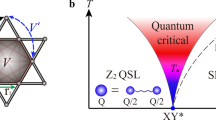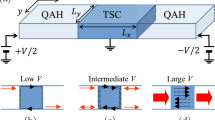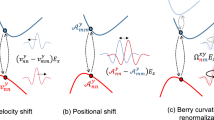Abstract
The fractional quantum Hall effect and superconductivity, remarkable phenomena in their own right, can harbour even more exotic physics at their interface. In particular, coupling quantum Hall edges with a superconductor can create emergent excitations known as non-Abelian anyons that trap widely coveted Majorana fermion zero-modes and generalizations thereof. We uncover non-local transport signatures of these zero-modes that not only provide striking experimental signatures of the anyons, but moreover allow one to construct novel circuit elements, including superconducting current and voltage mirrors, fractional charge transistors and flux-based capacitors. Underlying this unusual transport is a phenomenon that we term ‘perfect Andreev conversion’—whereby quasiparticles propagating chirally at the edge reverse their electric charge as a result of hybridization with the zero-modes. Our findings suggest numerous experimental directions in the study of quantum-Hall–superconductor systems hybrids and highlight a fundamentally new application of non-Abelian anyons.
This is a preview of subscription content, access via your institution
Access options
Subscribe to this journal
Receive 12 print issues and online access
$209.00 per year
only $17.42 per issue
Buy this article
- Purchase on Springer Link
- Instant access to full article PDF
Prices may be subject to local taxes which are calculated during checkout





Similar content being viewed by others
References
Anderson, P. W. More is different. Science 177, 393–396 (1972).
Nayak, C., Simon, S. H., Stern, A., Freedman, M. & Das Sarma, S. Non-Abelian anyons and topological quantum computation. Rev. Mod. Phys. 80, 1083–1159 (2008).
Kitaev, A. Y. Unpaired Majorana fermions in quantum wires. Phys. Usp. 44, 131–136 (2001).
Fu, L. & Kane, C. L. Superconducting proximity effect and Majorana fermions at the surface of a topological insulator. Phys. Rev. Lett. 100, 096407 (2008).
Lutchyn, R. M., Sau, J. D. & Das Sarma, S. Majorana fermions and a topological phase transition in semiconductor–superconductor heterostructures. Phys. Rev. Lett. 105, 077001 (2010).
Oreg, Y., Refael, G. & von Oppen, F. Helical liquids and Majorana bound states in quantum wires. Phys. Rev. Lett. 105, 177002 (2010).
Choy, T-P., Edge, J. M., Akhmerov, A. R. & Beenakker, C. W. J. Majorana fermions emerging from magnetic nanoparticles on a superconductor without spin–orbit coupling. Phys. Rev. B 84, 195442 (2011).
Nadj-Perge, S., Drozdov, I. K., Bernevig, B. A. & Yazdani, A. Proposal for realizing Majorana fermions in chains of magnetic atoms on a superconductor. Phys. Rev. B 88, 020407 (2013).
Clarke, D. J., Alicea, J. & Shtengel, K. Exotic non-Abelian anyons from conventional fractional quantum Hall states. Nature Commun. 4, 1348 (2013).
Lindner, N. H., Berg, E., Refael, G. & Stern, A. Fractionalizing Majorana fermions: Non-Abelian statistics on the edges of abelian quantum Hall states. Phys. Rev. X 2, 041002 (2012).
Beenakker, C. W. J. Search for Majorana fermions in superconductors. Annu. Rev. Condens. Matter Phys. 4, 113–136 (2013).
Alicea, J. New directions in the pursuit of Majorana fermions in solid state systems. Rep. Prog. Phys. 75, 076501 (2012).
Leijnse, M. & Flensberg, K. Introduction to topological superconductivity and Majorana fermions. Semicond. Sci. Technol. 27, 124003 (2012).
Stanescu, T. D. & Tewari, S. Majorana fermions in semiconductor nanowires: Fundamentals, modeling, and experiment. J. Phys. Condens. Matter 25, 233201 (2013).
Cheng, M. Superconducting proximity effect on the edge of fractional topological insulators. Phys. Rev. B 86, 195126 (2012).
Fendley, P. Parafermionic edge zero modes in Zn-invariant spin chains. J. Stat. Mech. P11020 (2012).
Barkeshli, M. & Qi, X-L. Topological nematic states and non-Abelian lattice dislocations. Phys. Rev. X 2, 031013 (2012).
Vaezi, A. Fractional topological superconductor with fractionalized Majorana fermions. Phys. Rev. B 87, 035132 (2013).
Oreg, Y., Sela, E. & Stern, A. Fractional helical liquids in quantum wires. Phys. Rev. B 89, 115402 (2014).
Klinovaja, J. & Loss, D. Parafermions in interacting nanowire bundle. Phys. Rev. Lett. 112, 246403 (2014).
Klinovaja, J. & Loss, D. Time-reversal invariant parafermions in interacting Rashba nanowires. Phys. Rev. B 90, 045118 (2014).
Barkeshli, M., Jian, C-M. & Qi, X-L. Twist defects and projective non-Abelian braiding statistics. Phys. Rev. B 87, 045130 (2013).
Barkeshli, M. & Qi, X-L. Synthetic topological qubits in conventional bilayer quantum Hall systems. Preprint at http://arXiv.org/abs/1302.2673 (2013).
Sengupta, K., Žutić, I., Kwon, H-J., Yakovenko, V. M. & Das Sarma, S. Midgap edge states and pairing symmetry of quasi-one-dimensional organic superconductors. Phys. Rev. B 63, 144531 (2001).
Bolech, C. J. & Demler, E. Observing Majorana bound states in p-wave superconductors using noise measurements in tunneling experiments. Phys. Rev. Lett. 98, 237002 (2007).
Law, K. T., Lee, P. A. & Ng, T. K. Majorana fermion induced resonant Andreev reflection. Phys. Rev. Lett. 103, 237001 (2009).
Flensberg, K. Tunneling characteristics of a chain of Majorana bound states. Phys. Rev. B 82, 180516 (2010).
Wimmer, M., Akhmerov, A. R., Dahlhaus, J. P. & Beenakker, C. W. J. Quantum point contact as a probe of a topological superconductor. New J. Phys. 13, 053016 (2011).
Fidkowski, L., Alicea, J., Lindner, N. H., Lutchyn, R. M. & Fisher, M. P. A. Universal transport signatures of Majorana fermions in superconductor-Luttinger liquid junctions. Phys. Rev. B 85, 245121 (2012).
Lin, C-H., Sau, J. D. & Das Sarma, S. Zero-bias conductance peak in Majorana wires made of semiconductor/superconductor hybrid structures. Phys. Rev. B 86, 224511 (2012).
Affleck, I. & Giuliano, D. Topological superconductor–Luttinger liquid junctions. J. Stat. Mech. 2013, P06011 (2013).
Lutchyn, R. M. & Skrabacz, J. H. Transport properties of topological superconductor–Luttinger liquid junctions: A real-time Keldysh approach. Phys. Rev. B 88, 024511 (2013).
Nilsson, J., Akhmerov, A. R. & Beenakker, C. W. J. Splitting of a Cooper pair by a pair of Majorana bound states. Phys. Rev. Lett. 101, 120403 (2008).
Herrmann, L. G. et al. Carbon nanotubes as Cooper-pair beam splitters. Phys. Rev. Lett. 104, 026801 (2010).
Das, A. et al. High-efficiency Cooper pair splitting demonstrated by two-particle conductance resonance and positive noise cross-correlation. Nature Commun. 3, 1165 (2012).
Fu, L. & Kane, C. L. Probing neutral Majorana fermion edge modes with charge transport. Phys. Rev. Lett. 102, 216403 (2009).
Akhmerov, A. R., Nilsson, J. & Beenakker, C. W. J. Electrically detected interferometry of Majorana fermions in a topological insulator. Phys. Rev. Lett. 102, 216404 (2009).
Kane, C. L. & Fisher, M. P. A. Impurity scattering and transport of fractional quantum Hall edge states. Phys. Rev. B 51, 13449–13466 (1995).
Wen, X-G. Quantum Field Theory of Many-Body Systems. (Oxford Graduate Texts, Oxford Univ. Press, 2004).
Finck, A. D. K., Eisenstein, J. P., Pfeiffer, L. N. & West, K. W. Exciton transport and Andreev reflection in a bilayer quantum Hall system. Phys. Rev. Lett. 106, 236807 (2011).
Mong, R. S. K. et al. Universal topological quantum computation from a superconductor/Abelian quantum Hall heterostructure. Phys. Rev. X 4, 011036 (2014).
Halperin, B. I., Stern, A. & Girvin, S. M. dc voltage step-up transformer based on a bilayer ν = 1 quantum Hall system. Phys. Rev. B 67, 235313 (2003).
Acknowledgements
We are indebted to J. P. Eisenstein, M. P. A. Fisher, C. Nayak and A. Stern for numerous enlightening discussions. We also acknowledge funding from the NSF through grants DMR-1341822 (D.J.C. and J.A.) and DMR-0748925 (K.S.); the Alfred P. Sloan Foundation (J.A.); the DARPA QuEST program (K.S.); the Caltech Institute for Quantum Information and Matter, an NSF Physics Frontiers Center with support of the Gordon and Betty Moore Foundation; and the Walter Burke Institute for Theoretical Physics at Caltech.
Author information
Authors and Affiliations
Contributions
D.J.C. contributed the calculations and devised the circuit elements. The manuscript was written by D.J.C. and J.A., while additional reality checks were provided by J.A. and K.S.
Corresponding author
Ethics declarations
Competing interests
The authors declare no competing financial interests.
Supplementary information
Supplementary Information
Supplementary Information (PDF 306 kb)
Rights and permissions
About this article
Cite this article
Clarke, D., Alicea, J. & Shtengel, K. Exotic circuit elements from zero-modes in hybrid superconductor–quantum-Hall systems. Nature Phys 10, 877–882 (2014). https://doi.org/10.1038/nphys3114
Received:
Accepted:
Published:
Issue Date:
DOI: https://doi.org/10.1038/nphys3114
This article is cited by
-
Disorder-enabled Andreev reflection of a quantum Hall edge
Nature Communications (2023)
-
Evidence for chiral supercurrent in quantum Hall Josephson junctions
Nature (2023)
-
Interference of chiral Andreev edge states
Nature Physics (2020)
-
Majorana zero modes and long range edge correlation in interacting Kitaev chains: analytic solutions and density-matrix-renormalization-group study
Scientific Reports (2018)
-
Inducing superconducting correlation in quantum Hall edge states
Nature Physics (2017)



